从铜浸出的矿石堆中产生的酸盐排水引起的臭气
IF 5
2区 工程技术
Q1 ENGINEERING, CHEMICAL
引用次数: 0
摘要
本研究揭示了铜矿工业堆浸渣堆积场中风化物的矿物学复杂性,重点研究了它们与含盐酸性排水的关系,特别是在降雨事件中导致风化物快速溶解的情况下。利用拉曼光谱和SEM-EDS技术,鉴定了多种水合硫酸盐和氯化物(Cu、Mg、Na、Fe和Al)次生矿物,包括黄铁矿、镁黄铁矿、绢黄铁矿、钠黄钾铁矾、pickeringite、石膏、铝土矿、砂铜矿和钾辉石。这些矿物质表明与排土场排水的化学成分有内在联系,这反映在矿物洗涤水的结果中,表明酸性(pH 3.8)和盐水排水(总溶解固体,TDS >;10000 mg / L)。在花期中观察到一种独特的颜色序列,从浅蓝色和淡绿色的黄铁矿-镁-黄铁矿晶体到黄色钠黄钾铁矾的叶状层和球状的绢黄铁矿和针状的pickeringite层。垃圾场斜坡上的盐壳显示出大面积的白色和棕色石膏,上面有黄铁矿和镁黄铁矿的晶体,上面覆盖着简单的白色硫酸铝和镁。此外,本研究提出了奥伯铁矿-镁-奥伯铁矿系列的广义光谱模式,突出了硫酸盐的关键振动模式,以及间隙氯离子对水分子振动模式的潜在影响。该研究提供了有关排土场矿物变异性和环境条件的宝贵信息,为理解铜开采中盐碱排水的形成过程提供了一个视角。本文章由计算机程序翻译,如有差异,请以英文原文为准。

Efflorescences associated with acid-saline drainage from a dump of copper-leached ores
This study reveals the mineralogical complexity of efflorescences in heap-leaching residues dump of the copper mining industry, focusing on their relationship with saline acid drainages, particularly during rainfall events that cause rapid dissolution of the efflorescences. Using Raman spectroscopy and SEM-EDS techniques, various secondary minerals of hydrated sulphate and chloride (Cu, Mg, Na, Fe, and Al) were identified, including aubertite, magnesium-aubertite, tamarugite, natrojarosite, pickeringite, gypsum, alunogen, sanderite, and kieserite. These minerals suggest an intrinsic connection with the chemical composition of the dump drainage, as reflected in the results of the mineral wash water, indicating acidic (pH 3.8) and saline drainage (total dissolved solids, TDS > 10,000 mg/L). A distinctive colour sequence was observed in the efflorescences, ranging from bluish and greenish crystals of aubertite-magnesium-aubertite to yellow botryoidal layers of natrojarosite and globular white layers of tamarugite and acicular pickeringite. The saline crusts on the slopes of the dumpsites showed extensive areas of white and brown gypsum, with crystals of aubertite and magnesium-aubertite, covered by simple white sulphate salts of Al and Mg. Furthermore, this study presents a generalized spectral pattern for the aubertite—magnesium-aubertite series, highlighting key vibration modes of sulphate, as well as the potential influence of interstitial chloride ions on the vibration modes of water molecules. This study provides valuable information on mineral variability and environmental conditions in the dump sites, offering a perspective for understanding the formation processes of saline acid drainages in copper mining.
求助全文
通过发布文献求助,成功后即可免费获取论文全文。
去求助
来源期刊

Minerals Engineering
工程技术-工程:化工
CiteScore
8.70
自引率
18.80%
发文量
519
审稿时长
81 days
期刊介绍:
The purpose of the journal is to provide for the rapid publication of topical papers featuring the latest developments in the allied fields of mineral processing and extractive metallurgy. Its wide ranging coverage of research and practical (operating) topics includes physical separation methods, such as comminution, flotation concentration and dewatering, chemical methods such as bio-, hydro-, and electro-metallurgy, analytical techniques, process control, simulation and instrumentation, and mineralogical aspects of processing. Environmental issues, particularly those pertaining to sustainable development, will also be strongly covered.
 求助内容:
求助内容: 应助结果提醒方式:
应助结果提醒方式:


